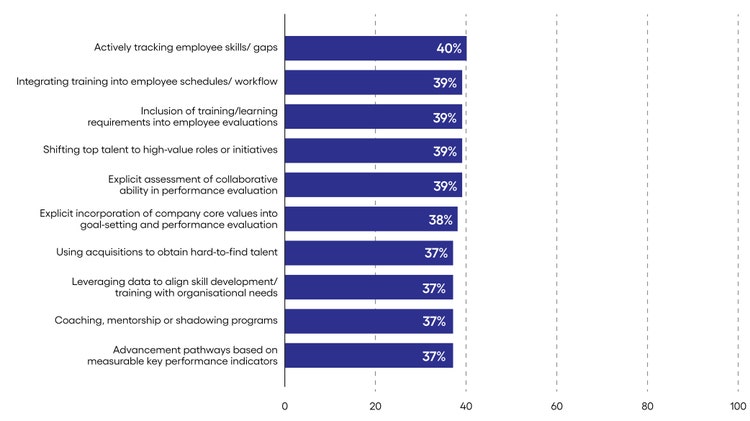
How to build modern HR operations
data-xy-axis-lg:null; data-xy-axis-md:90% 0%; data-xy-axis-sm:null
<p><br> March 29, 2023</p>
How to build modern HR operations
<p><b>The world is changing, and the work of managing Human Resources must change with it. This journey will see traditional HR functions evolving to place employee experience front and center.</b></p>
<p>According to <a href="https://www.aon.com/unitedkingdom/employee-benefits/resources/benefits-and-trends/default.jsp" target="_blank">Aon</a>, 93% of companies think employees' work expectations are changing. And while some expectations are broadly shared across the workforce—such as the desire for flexible working, or access to robust career-development plans—there is a growing need for HR to target the specific needs of groups and individuals.</p> <p>Yet, for many businesses, significant challenges remain as HR leaders struggle to shift from one-size-fits-all legacy operations to personalized approaches that meet employee expectations at an individual level. First and foremost, they lack the processes and data they need to approach employees on a personal level, understand their work-goals, and provide the services required to achieve them.</p> <p>To understand how to reach this paradise of personalization, Economist Impact, supported by Cognizant, conducted research into the key attributes of a future-ready business. We identified ten critical talent initiatives that businesses must implement to give their talent development and HR functions the best chance of weathering periods of volatility.</p>

#
<p><span class="small">Response base: 2,000 senior leaders<br> Source: Economist Impact Survey 2022</span></p> <p><span class="small">Figure 1</span></p> <p>As you can see, none of these crucial initiatives is in place at more than 40% of companies surveyed, suggesting that most HR departments are woefully unprepared for the challenges ahead.</p> <h4>Meet worker expectations for hyper-personalized experiences</h4> <p>In almost every aspect of their consumer lives, today’s workers enjoy hyper-personalized services. Whether it’s tailored recommendations from their favorite online store, or targeted content based on their browsing habits and interests. Yet, their experience in the workplace often falls far short of what is rapidly becoming a baseline expectation.</p> <p>The reality is modern HR operations that bring tailored services and solutions to employees enjoy considerable advantages over competitors. A recent <a href="https://www.cognizant.com/us/en/insights/perspectives/closing-the-purpose-gap" target="_blank">report from Cognizant Research</a>, for example, highlights the growing "purpose gap" in which younger workers crave greater purpose at work (fewer than one in five younger workers strongly believe they are living their purpose at work). Older generations, on the other hand, tend to report a greater sense of fulfilment. An HR strategy that targets younger workers with reminders of their work’s larger social purpose, therefore, while focusing on, say, retirement advice for older workers, will automatically have an edge in employee retention over a strategy that treats all generations the same.</p> <p>Similarly, in much the same way that ecommerce applications recommend products based on our browsing habits and previous consumption, HR organizations can recommend training topics based on roles, experience, and historic training preferences. They can push shorter courses to those with a history of completing bitesize training rather than longer courses. Or highlight the training opportunities that align with their specific career development goals. Tailored career development programs can really help employees understand the value they bring today, and the new opportunities awaiting them in the future.</p> <h4>Bring data into the heart of HR</h4> <p>What is the common thread of all these initiatives? Data. Before you can offer individualized communications, resources, and services to employees, you need quality data on who your employees are—as individuals. For most HR departments this will require a rapid expansion of their data-gathering and analysis capabilities. According to Aon, many businesses are now augmenting their regular engagement surveys of employee sentiment with more frequent ‘pulse’ surveys. A small number of firms (3%) are even looking to run more surveys informed by neuroscience, which tap into the respondent’s unconscious mind to get an unfiltered view of their feelings.</p> <p>Yet, looking back at the graph above, we see that data-intensive activities are particularly underserved by most businesses today. Even rudimentary initiatives, such as tracking employee skills gaps and development needs, are off the radar for most businesses. Let alone more advanced capabilities, such as leveraging data to align skills development and training with the needs of the modern business.</p> <p>The same study, however, showed that investment in talent, and using data to drive better HR outcomes, <a href="https://impact.economist.com/projects/future-ready-business/#talent-01" target="_blank">tracked directly with improved business performance</a> (in particular, strong workforce and talent practices are associated with product and service innovation, technological readiness, and social sustainability). To realize this, then, HR leaders must start building a robust data strategy to inform HR strategy. By actively tracking employee skills gaps, for example, leaders can more intelligently respond to changing business needs. And through regular sentiment surveys, they can look to reverse actions that negatively impact the employee experience before they have a material impact on teams.</p> <h4>Plot out the employee journey and start tackling pain points</h4> <p>Data cannot signpost our modernization journey alone. We need valuable context that prioritizes and fuels the best courses of action. To get this, first we must understand our employee journeys across HR. Where are the pain points from an employee’s perspective? And what parts do they appreciate and value? The goal is to find those ‘moments that matter’ that make-or-break employee experiences. Perhaps it’s the jarring experience of arriving on their first day and finding their laptop is still with IT. Or the hugely positive experience of a senior leader personally welcoming them and showing them around. These moments that matter, well, they matter. And HR professionals need to go digging to find out what they are—and their relative importance to individual employees.</p> <p>Data coupled with this context enables HR functions to start truly impacting the employee experience and prioritizing the highest value initiatives.</p> <p>Take onboarding processes. In the past, businesses have gotten away with interminable, complex, and often invasive onboarding processes. But today, candidate experience is sacrosanct. And in a hot talent market, those traditional multi-month run-times may be the difference between you getting top talent, and your sleeker faster competitor hoovering up the cream of the crop. By plotting out the candidate’s journey and mapping it to data (such as outputs from pulse surveys that gauge employee sentiment at different stages of the journey), HR professionals are equipped to highlight the major “pain points” of the onboarding process and find ways to make them less burdensome.</p> <h4>With more HR challenges on the horizon, now’s the time to strike</h4> <p>Whether it is keeping today’s workforce engaged, or developing talent pipelines to meet business growth, today’s HR leaders have their work cut out for them. The only way forward is to prioritize those transformation efforts that have the most positive impact on the employee experience. Armed with valuable data and context, HR teams can tackle destructive pain points, and strengthen positive experiences.</p> <p>The truth is business success is inextricably tied to investment in talent. Indeed, in <a href="https://impact.economist.com/projects/future-ready-business/#talent-01" target="_blank">research conducted by Economist Impact and supported by Cognizant</a>, the maturity and strength of a business’s performance aligned perfectly with the amount invested in talent strategies. Those that invested the most, enjoyed the best results. So, for all HR professionals, now is the time to strike.</p> <p><i>To learn more, visit the <a href="https://www.cognizant.com/us/en/services/business-process-services/employee-experience-enterprise-services" target="_blank">Employee Experience</a> section of our website or <a href="https://www.cognizant.com/us/en/about-cognizant/contact-us" target="_blank">contact us</a>.</i></p> <p><i>This article was written by Putul Mathur, Vice President, HR Operations at Cognizant.</i></p>
<p>We’re here to offer you practical and unique solutions to today’s most pressing technology challenges. Across industries and markets, get inspired today for success tomorrow.</p>
